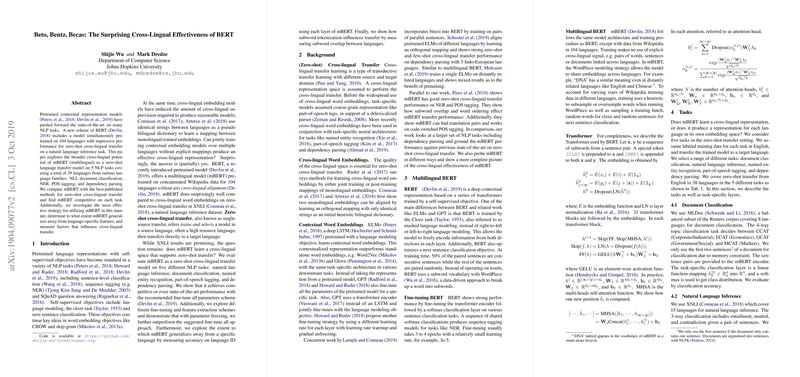Analyzing the Cross-Lingual Capabilities of Multilingual BERT
The paper entitled "Beto, Bentz, Becas: The Surprising Cross-Lingual Effectiveness of BERT" investigates the potential of the multilingual BERT model (mBERT) for zero-shot cross-lingual transfer across five distinct NLP tasks, encompassing 39 different languages. This analysis provides a nuanced evaluation of mBERT in comparison to existing methods, revealing insights into its performance and adaptability in multilingual settings.
Overview of Multilingual BERT
mBERT extends the architecture of the original BERT by incorporating training inputs from 104 languages, using Wikipedia as the data source without explicit cross-lingual alignment. The model strategy leverages shared subword representations via WordPiece tokenization, enabling the model to capture multilingual contextual embeddings effectively.
Evaluation on Diverse NLP Tasks
The research assesses mBERT across five tasks:
- Document Classification (MLDoc): The model demonstrates competitive results against existing multilingual embeddings, notably excelling in languages such as Chinese and Russian.
- Natural Language Inference (XNLI): mBERT outperforms baseline models lacking cross-lingual training data but falls behind those leveraging bitext, pointing towards the benefits of targeted multilingual pretraining.
- Named Entity Recognition (NER): mBERT significantly surpasses previous models utilizing bilingual embeddings, marking an improvement of 6.9 points in F1 on average.
- Part-of-Speech Tagging (POS) and Dependency Parsing: The model showcases robust performance, especially evident in parsing tasks where it gains 7.3 points in UAS over baseline methods, highlighting its capability even without POS tag availability.
Examination of Layer-Specific Behavior
The paper explores the impact of different mBERT layers on zero-shot transfer performance. Freezing the lower layers showed notable improvements across tasks, suggesting higher layers effectively capture cross-lingual representations while retaining language-specific features, as confirmed by language classification tests.
Implications and Future Directions
The implications of these findings suggest promising applications for mBERT in multilingual NLP scenarios, especially in zero-shot contexts. Future work could incorporate weak supervision to enhance cross-lingual alignment, potentially addressing limitations in low-resource settings. Additionally, exploring linguistic characteristics within mBERT's learned representations could shed light on multilingual model generalization.
In conclusion, this paper provides a thorough evaluation of mBERT's cross-lingual effectiveness, opening avenues for further research in multilingual model development and adaptation. The findings underscore mBERT’s significant potential in advancing multilingual NLP applications with its substantial ability to handle multiple languages without explicit cross-lingual resources.
